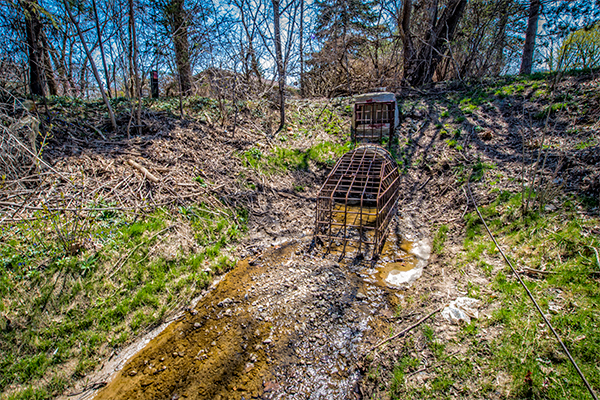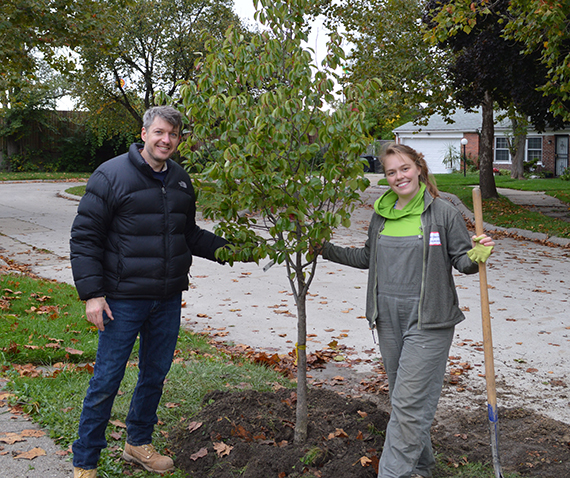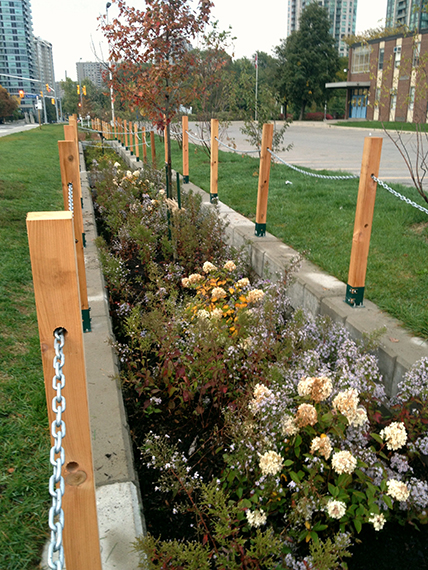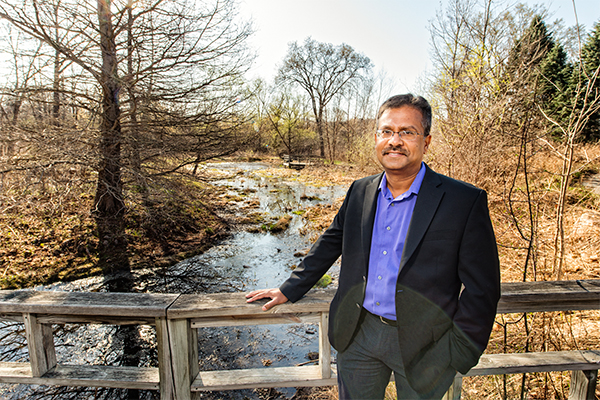Healing fractured water: Great Lakes cities look to reintegrate the urban water cycle
Nina Ignaczak |
Wednesday, May 06, 2015
This piece is made possible through a partnership with the Great Lakes Commission through the Greater Lakes project, with support from the Great Lakes Protection Fund.
All across the Great Lakes region, natural water systems are fractured by an aging infrastructure of concrete, pipes, and pavement.
The problem is the result of decades of incremental change writ large across the landscape. As people began re-engineering their watersheds, separating and isolating components of the natural water cycle to extract benefit for human habitation, they created a system in which the natural relationship of rainwater with lakes, streams, rivers, and groundwater has been altered. As a result, a great deal of economic and ecological value has been lost, and the treatment of municipal water and wastewater is more costly than it might otherwise be.
In most cities across the Great Lakes today, stormwater, municipal water supply, and wastewater systems are handled independently of one another in separate administrative entities with separate regulations and funding sources. A stormwater operator for a city may rarely meet a wastewater manager or a water supply professional; there is no requirement in today's water management paradigm for them to communicate or collaborate.
 Mallett's Creek in downtown Ann Arbor is partially buried within the city and suffers from stormwater overload and a lack of connection to the natural water cycle.
Lost efficiencies, increased costs and ecological degradation result. Lakes, rivers, and streams are cut off from their source of replenishment; waterways are alternately choked with runoff and sediment or desiccated due to lack of stream flow; and communities are forced to import water from a distance because their own aquifers are tapped out. Wastewater treatment costs increase as plants must use more energy to pump water to dilute effluent.
Modern water systems in the Great Lakes have lost much of their intrinsic ecological and economic benefit. Fortunately, local governments and community groups in cities like Toronto
Mallett's Creek in downtown Ann Arbor is partially buried within the city and suffers from stormwater overload and a lack of connection to the natural water cycle.
Lost efficiencies, increased costs and ecological degradation result. Lakes, rivers, and streams are cut off from their source of replenishment; waterways are alternately choked with runoff and sediment or desiccated due to lack of stream flow; and communities are forced to import water from a distance because their own aquifers are tapped out. Wastewater treatment costs increase as plants must use more energy to pump water to dilute effluent.
Modern water systems in the Great Lakes have lost much of their intrinsic ecological and economic benefit. Fortunately, local governments and community groups in cities like Toronto and
Detroit are working toward changing that.
They face a huge challenge; they must re-imagine the very premise on which modern water utilities function, from planning to operations to funding. They must sell the use of "green infrastructure" (using natural systems like plants and soil to treat and manage stormwater) in a culture very much entrenched in using traditional "grey infrastructure" (pipes and concrete storage tanks) to manage water in urban areas.
Their ultimate task: reintegrating the way water systems are managed to capture the efficiencies of the natural water cycle, reducing costs and increasing ecological and economic sustainability and resiliency in the process.
The Great Lakes Commission's
Greater Lakes project, funded through the Great Lakes Protection Fund, is designed to help local governments and watershed managers to meet this challenge.
Building a New Water Management Paradigm
"To improve water quality, reduce erosion, and build resiliency in light of climate change, we need to adopt green infrastructure," says Christine Zimmer, senior manager of watershed protection and restoration for the Credit Valley Conservation Authority (CVCA) and an adviser to the Greater Lakes project. The authority is one of 36 nonprofit conservation authorities in Ontario that works with multiple levels of government and community groups to improve watershed function.
 Christine Zimmer, senior manager of watershed protection and restoration for the Credit Valley Conservation Authority (CVCA) and an adviser to the Greater Lakes project.
The Credit Valley is a 1,000 square-kilometer (386 square-mile) watershed west of Toronto. The basin consists of rural headwaters in Orangeville, and flows through Brampton, one of the fastest-growing municipalities in North America, before draining into Lake Ontario.
"We advocate for making integrated decisions to optimize systems," says Zimmer. "When you have less stream flow during dry weather periods, that impacts how well the wastewater treatment plant can dilute. So, if you go back into these urban areas and you retrofit, you can maintain those stream flows during dry weather to help dilute the wastewater."
Zimmer's organization promotes retrofitting the water systems in existing urban areas, with an emphasis on optimal techniques for each of the different types of land uses found in urban watersheds.
"Up to 50 percent of municipal water use in residential and commercial areas is used for lawn watering," says Zimmer. "So, if we really want to make a dent in water conservation, while techniques like low-flow showers and low-flow toilets are great, really making a dent in lawn watering is a very big bang for your buck."
But instead of advocating for regulation on water use, Zimmer’s group works on projects to incorporate green infrastructure elements like rain gardens or permeable driveways into residential areas. These types of systems achieve complementary results to support integrated water management. They absorb rainwater runoff, thereby restoring natural ecological function, while also reducing the need for using municipal water for landscape irrigation.
"That's a really good way to reduce your lawn watering, as well as reduce stormwater impact," she says.
This is particularly important in older areas, according to Zimmer, where stormwater may not be treated at all. But retrofitting older areas will be a costly proposition.
"Attention is shifting to Canada’s aging infrastructure, which is in need of rapid repair and replacement, with a total cost amounting to $170 billion for water supply, wastewater, stormwater and road infrastructure stock nationally," says Zimmer. "Ontario accounts for almost 60 percent of that. It is estimated that only 35 percent of the greater Toronto area has stormwater quality treatment. To bring these older developments across the nation to today’s standards, it is estimated to cost an additional $56.6 billion."
And that figure, Zimmer notes, does not include costs for acquiring the land on which to build infrastructure, which in urban areas like Toronto can triple or quadruple the price of a project.
A Vision for Water Sustainability
In Detroit, water infrastructure is also aging and in need of replacement. But land costs are far less of an issue.
Dan Kinkead is director of projects for the Detroit Future City Implementation Office, an independent group working with the community and
Christine Zimmer, senior manager of watershed protection and restoration for the Credit Valley Conservation Authority (CVCA) and an adviser to the Greater Lakes project.
The Credit Valley is a 1,000 square-kilometer (386 square-mile) watershed west of Toronto. The basin consists of rural headwaters in Orangeville, and flows through Brampton, one of the fastest-growing municipalities in North America, before draining into Lake Ontario.
"We advocate for making integrated decisions to optimize systems," says Zimmer. "When you have less stream flow during dry weather periods, that impacts how well the wastewater treatment plant can dilute. So, if you go back into these urban areas and you retrofit, you can maintain those stream flows during dry weather to help dilute the wastewater."
Zimmer's organization promotes retrofitting the water systems in existing urban areas, with an emphasis on optimal techniques for each of the different types of land uses found in urban watersheds.
"Up to 50 percent of municipal water use in residential and commercial areas is used for lawn watering," says Zimmer. "So, if we really want to make a dent in water conservation, while techniques like low-flow showers and low-flow toilets are great, really making a dent in lawn watering is a very big bang for your buck."
But instead of advocating for regulation on water use, Zimmer’s group works on projects to incorporate green infrastructure elements like rain gardens or permeable driveways into residential areas. These types of systems achieve complementary results to support integrated water management. They absorb rainwater runoff, thereby restoring natural ecological function, while also reducing the need for using municipal water for landscape irrigation.
"That's a really good way to reduce your lawn watering, as well as reduce stormwater impact," she says.
This is particularly important in older areas, according to Zimmer, where stormwater may not be treated at all. But retrofitting older areas will be a costly proposition.
"Attention is shifting to Canada’s aging infrastructure, which is in need of rapid repair and replacement, with a total cost amounting to $170 billion for water supply, wastewater, stormwater and road infrastructure stock nationally," says Zimmer. "Ontario accounts for almost 60 percent of that. It is estimated that only 35 percent of the greater Toronto area has stormwater quality treatment. To bring these older developments across the nation to today’s standards, it is estimated to cost an additional $56.6 billion."
And that figure, Zimmer notes, does not include costs for acquiring the land on which to build infrastructure, which in urban areas like Toronto can triple or quadruple the price of a project.
A Vision for Water Sustainability
In Detroit, water infrastructure is also aging and in need of replacement. But land costs are far less of an issue.
Dan Kinkead is director of projects for the Detroit Future City Implementation Office, an independent group working with the community and a range of public, private, and non-profit partners to implement the strategic framework,
Detroit Future City.
"I think Detroit has an opportunity to do something that other cities simply do not," says Kinkead. "We're looking to leverage and transform this existing set of liabilities we have with our vacant land into a huge asset."
Kinkead says the city is looking at implementing green infrastructure in two ways.
"First, as an adaptive reuse mechanism for vacant land in the city; to complement existing fixed infrastructure, reduce existing and future capital and operational costs, provide better stormwater management and reduce our combined sewer overflows," he says. "The second is to understand how Detroit can become a leader in deployment of green infrastructure, and how that can begin to have a multifaceted impact, not just regarding stormwater management and CSO's, but also for energy production, water storage, air quality and to reduce the urban heat island effect."
 Dan Kinkead and Greening of Detroit volunteer Christanna Schuman plant a tree in Detroit.
Dan Kinkead and Greening of Detroit volunteer Christanna Schuman plant a tree in Detroit.
Green infrastructure also provides a way to address the social justice challenges in Detroit, according to Kinkead.
"The city has significant vacancy where there's major blight, and really no discernible market for future development," he says. "These are also areas where we tend to have concentrations of folks that tend to be poor, tend to be older, are often people of color, and have limited access to transportation. For many folks in these areas, their quality of life is extremely poor, and then they are dealing with an environment in which you still have paved areas that contribute to the urban heat island effect. Deaths due to high heat events occur primarily in our senior population. If we can begin to think about how to deploy green infrastructure, such as tree planting, to mitigate that heat island effect, I think there's a transformative impact that can be made for residents."
The key in Detroit, Kinkead says, is to "right-size" the water system.
"From all sides, from supply, from waste and from stormwater, we see huge opportunities to appropriately size and maintain our existing water system, which is much larger than what we need right now and is quite expensive to maintain," he says. "This can ensure better performance for residents, while improving health, and reducing ecological impacts."
To that end, Kinkead's group is working with the Detroit Water and Sewerage Department, or DWSD, to reduce the burden on the system and ultimately reduce capital and operating costs through green infrastructure.
"Given the availability of land in this area, we think that can be actually deployed in a lot of different locations," he says.
Integrated Management, Integrated Financing
Replacing aging infrastructure while changing the water management paradigm is going to require adequate funding, according to Zimmer. And in most communities across the Great Lakes, stormwater treatment, unlike drinking water and wastewater, is largely unfunded.
 The Elm Drive Rain Garden in Mississauga, Ontario absorbs road runoff. She notes that communities in Canada are starting to address the need to fund stormwater as a critical component of advancing more integrated water management.
"Setting aside dedicated funding to maintain stormwater features, whether it's green infrastructure or grey infrastructure, has been difficult." says Zimmer. "If a water main breaks, right away there's municipal funding to support fixing that water main leak, because there's a direct impact; residences have no water, or a business has no water. Stormwater doesn't have that same luxury. So more municipalities are now starting to look at a stormwater rate based on impervious cover."
Jim Ridgway is a vice president at Environmental Consulting & Technology, a water resources consulting firm and part of the Greater Lakes project team. He worked with communities in southeast Michigan and Ontario on a project to examine the most cost-efficient ways to integrate water management. The project was funded by the Great Lakes Protection Fund
The Elm Drive Rain Garden in Mississauga, Ontario absorbs road runoff. She notes that communities in Canada are starting to address the need to fund stormwater as a critical component of advancing more integrated water management.
"Setting aside dedicated funding to maintain stormwater features, whether it's green infrastructure or grey infrastructure, has been difficult." says Zimmer. "If a water main breaks, right away there's municipal funding to support fixing that water main leak, because there's a direct impact; residences have no water, or a business has no water. Stormwater doesn't have that same luxury. So more municipalities are now starting to look at a stormwater rate based on impervious cover."
Jim Ridgway is a vice president at Environmental Consulting & Technology, a water resources consulting firm and part of the Greater Lakes project team. He worked with communities in southeast Michigan and Ontario on a project to examine the most cost-efficient ways to integrate water management. The project was funded by the Great Lakes Protection Fund.
Ridgway says that a dedicated funding source will be critical to fully realizing the potential of integrated water management. In Michigan, local governments are restricted in their ability to levy additional taxes due to the state's "Headlee" Amendment, and a court decision (
Bolt v. Lansing) makes it very challenging to establish utility fees for stormwater. As a result, many of the green infrastructure projects implemented in Michigan are funded through philanthropy and grant programs. And maintaining those grant-funded projects is always a challenge.
"If you have a grant program that pays for green infrastructure, it works great, but because it's a grant program, it's small," he says. "But if you have a regulation that is internalizing the cost of stormwater, then people do the right things."
Ridgway points to communities such as the City of Ann Arbor and the City of St. Clair Shores, which have stormwater utilities. They are not only able to construct stormwater management infrastructure, but also maintain it. The DWSD also has such a fee, but has not uniformly enforced it over the years, according to Ridgway.
"Overall, it really boils down to the fact that you need a way to monetize the value of stormwater," he says. It points not to the broken way we manage stormwater, but the broken way we pay for it. With city water, we're used to it, so if you use two gallons, you pay for two gallons. Sewage is the same, even though it's tied to a water meter. But stormwater is free, and it's so hidden."
To fund integrated water management, ECT is also looking at options to leverage market-based, private investment for green infrastructure, with support from the GLPF.
"Historically, upfront capital needed for the construction of infrastructure projects has almost exclusively been the responsibility of government," says Sanjiv Sinha, Ph.D., vice president for water resources at ECT and the project manager for the above mentioned GLPF-funded report. “That paradigm is slowly changing due to the emergence of public-private partnerships (also known as P3s).”
 Sanjiv Sinha, Ph.D., vice president for water resources at ECT and the project manager for a GLPF-funded study that identifies options for leveraging private investment for green infrastructure.
The report offers a business model framework for aggregating green infrastructure projects into bundles to make them attractive for private investment, similar to what is currently being pioneered with solar panels in the renewable electricity distributed generation market.
P3s assist the public sector with infrastructure investments that need upfront capital. ECT believes private financing represents a significant opportunity to help heal fractured water systems through "conservation impact investments," a term that describes private investment that, in addition to offering a positive return-on-investment, achieves environmental and social benefits.
“Between 2009 and 2013, global conservation impact investments from private investors totaled over $1.9 billion, and these investments grew at an average annual rate of nearly 26 percent," says Sinha. "Challenges to future investments include a shortage of deals with appropriate scale and risk/return profiles, not a lack of capital.”
Green infrastructure is generally cheaper than grey infrastructure. If it can be implemented at a large enough scale, even if distributed across the landscape in small projects, and used as part of an integrated water management approach, Sinha thinks it has the potential to be a game-changer in the years to come.
"P3 based models will likely be replicated elsewhere in the country, including the Great Lakes basin”, says Sinha. “If it helps build distributed green infrastructure at the scale of couple of thousand acres in every county, it will go a long way in helping heal fractured water systems.”
Sanjiv Sinha, Ph.D., vice president for water resources at ECT and the project manager for a GLPF-funded study that identifies options for leveraging private investment for green infrastructure.
The report offers a business model framework for aggregating green infrastructure projects into bundles to make them attractive for private investment, similar to what is currently being pioneered with solar panels in the renewable electricity distributed generation market.
P3s assist the public sector with infrastructure investments that need upfront capital. ECT believes private financing represents a significant opportunity to help heal fractured water systems through "conservation impact investments," a term that describes private investment that, in addition to offering a positive return-on-investment, achieves environmental and social benefits.
“Between 2009 and 2013, global conservation impact investments from private investors totaled over $1.9 billion, and these investments grew at an average annual rate of nearly 26 percent," says Sinha. "Challenges to future investments include a shortage of deals with appropriate scale and risk/return profiles, not a lack of capital.”
Green infrastructure is generally cheaper than grey infrastructure. If it can be implemented at a large enough scale, even if distributed across the landscape in small projects, and used as part of an integrated water management approach, Sinha thinks it has the potential to be a game-changer in the years to come.
"P3 based models will likely be replicated elsewhere in the country, including the Great Lakes basin”, says Sinha. “If it helps build distributed green infrastructure at the scale of couple of thousand acres in every county, it will go a long way in helping heal fractured water systems.”
 Stay tuned for our next piece in this series about solutions to heal fractured water systems across the Great Lakes. Read the earlier stories in this series here and in our sister publication, Model D.
Stay tuned for our next piece in this series about solutions to heal fractured water systems across the Great Lakes. Read the earlier stories in this series here and in our sister publication, Model D.